Project management methodologies
A project management methodology is how you go about managing your projects – what are the methods used? There are many project management methodologies but here are the most popular:
Waterfall Methodology
Under this methodology things are done in a sequence which is generally:
Requirements Phase
Here the client, for whom you are doing the project, is interviewed and their requirements are understood: what do they require from this project? It is best to document requirements and then get your client to agree to them formally.
Specification Phase
Here specifications are drawn up for what the project will deliver. If it is a product what will be the designed characteristics of the product. If a service what will be the characteristics of the service?
Implementation Phase
How will the project be implemented? How will you go about delivering the project?
Quality Assurance Phase
Never make a product or service available without quality assurance checks first, to ensure that your product or service will be delivered at an appropriate standard.
On conclusion of the above phases, which may take many months or even years, you can launch your product or service.
The Project Management Institute’s (PMI) Project Management Body Of Knowledge guide (PMBOK)
The project Management Institute is an American organisation which collates and publishes regular updates to its PMBOK manual. This manual contains a lot of information about project management best practices and is one of the best books to read for those knew to the discipline. It covers:
- project life cycle
- project organisation
- key roles in project management e.g. stakeholder
- processes for a project
- risk analysis
- scheduling
- estimating
- execution
- teams
- monitoring
- scope
- project charter
- project plan
- change control
- budget
- quality management
- resource management
- communications
The information given in the PMBOK is as detailed and as credible as can be found anywhere, and is backed up by extensive practitioner experience and knowledge.
COBIT – Control Objectives for Information and Related Technology
As its name implies COBIT grew out of information technology. Often described as en enterprise management methodology, COBIT features 37 disctinct processes in several areas:
- Governance
- Management
- APO
COBIT uses specialised terminology and requires training to understand. It is a complex methodology.
The PDCA (Plan-Do-Check-Act)
This simple methodology is seen as best suited to smaller organisations and projects and the phases are:
- plan the work
- do the work
- check performance against the plan
- act to take actions to stop or prevent deviation from the plan
- plan and start the cycle again…
Critical Chain Project Management (CCPM)
In this methodology the critical chain is a critical path which is immune to most changes. Uncertainty is built into each activity path as a buffer and this protects the overall progress of the project. Buffer management is a feature of managing the project.
Critical Path Methodology
Here the project managers plan the tasks as critical tasks to deliver the project successfully, and then less important tasks. Each critical task is dependent on previous critical tasks. For example in a construction project there might be the following critical tasks:
- lay the foundations of the building
- construction of the walls
- construction of the roof
If the foundations are not complete, the walls and roof cannot be built, so there is a dependency of one task on another. The sequence of critical tasks is called the critical path.
Lesser tasks, such as painting doors, are not critical and can be left if necessary while effort is concentrated on the critical tasks.
Agile Methodologies
There are many agile methodologies, but they all try and implement a people-focused way of working, and to priorities regular and often informal communications over rigid formal processes. The agile approach is very different from the waterfall approach in that complex documentation is generally not drawn up in advance, instead the product or service is designed in cooperation with the client, making changes as the team goes along. This type of project is considered more modern and flexible than more traditional project methodologies.
Scrum
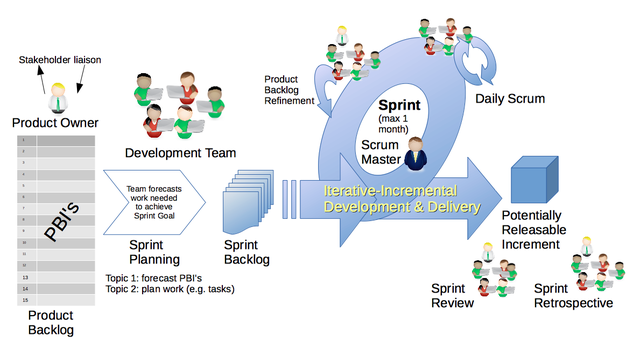 {: .img-fluid}
{: .img-fluid}
Scrum breaks project delivery into sprints which usually last between 2 and 4 weeks, and at the end of each sprint there is something delivered which can be seen by the project stakeholders. The idea is that stakeholders can see progress for themselves and steer the project as it progresses. In theory scrum should prevent big project disasters where the delivered product is not what the stakeholders envisaged.
In scrum all work is in the backlog, and as teams complete an item of work they take another from the backlog. There is a daily meeting to quickly discuss progress and the whole process is overseen by the scrum master whose job is to deal with any progress blockers such as problems.
Kanban
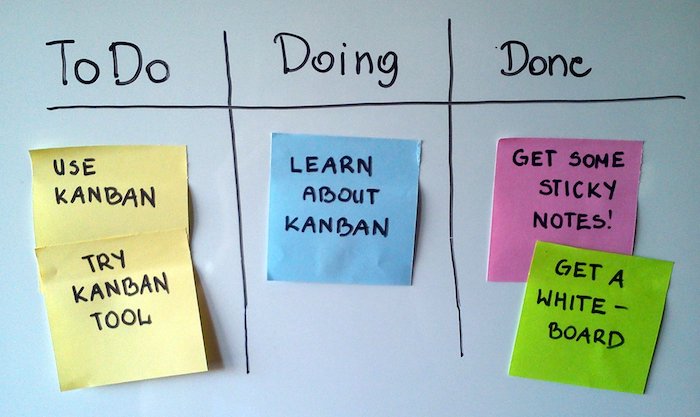 {: .img-fluid}
{: .img-fluid}
Developed in Japan, this method uses the kanban board to sort tasks into various columns or statuses and provides a powerful visual system for managing projects and tasks. Kanban boards are finding their way into many forms of project management.
The above kanban board is a simple example, but there can be many columns in the board in addition to the classic ‘To Do’, ‘Doing’ and ‘Done’. The board can track a piece of work through each stage of a process, and each column in the board can also represent a team. For example kanban columns in car production could be assembly, painting, test driving, transportation to showroom etc.
Well motivated kanban teams can work fast, because as soon as they complete a task they pick up the next task coming in on the kanban board. It is a simple but powerful system.
Systems Development Life Cycle Management (SDLCM)
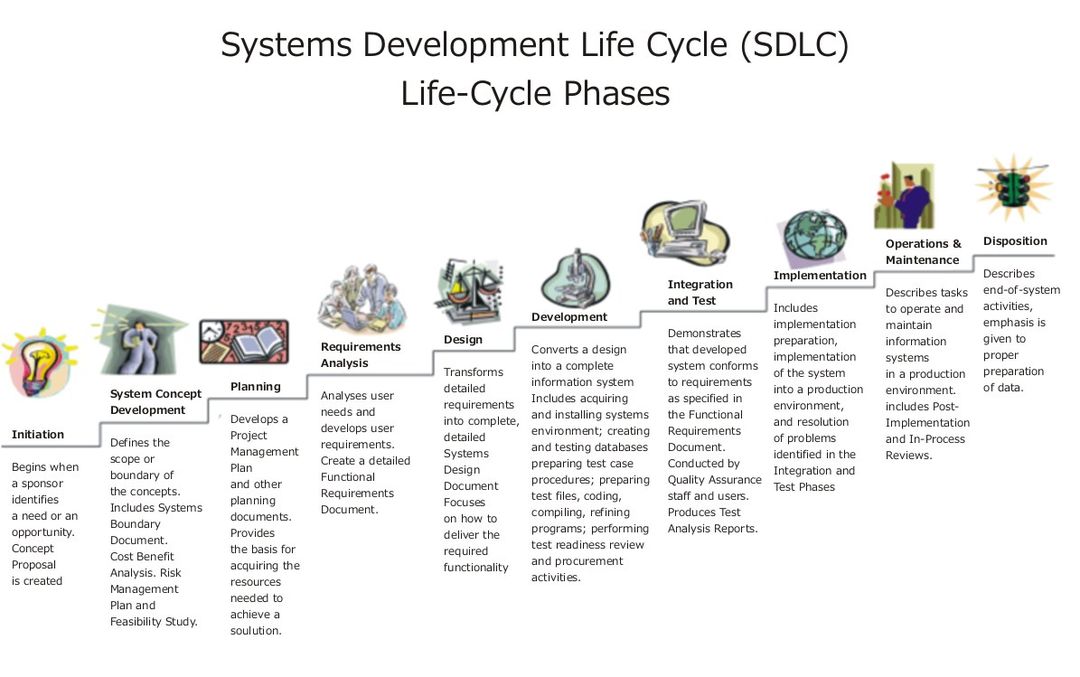 {: .img-fluid}
{: .img-fluid}
This methodology was developed by the U.S. Nuclear Regulatory Commission. It has 7 components:
- Define initial project requirements
- Acquire support resources
- Design
- Engineer
- Deploy
- Service
- Decommission
This is another complex methodology which requires reading and training to adopt, and benefits organisations where riskier agile style approaches are unsatisfactory. That it originated in the nuclear industry speaks volumes.
Information Technology Infrastructure Library (ITIL)
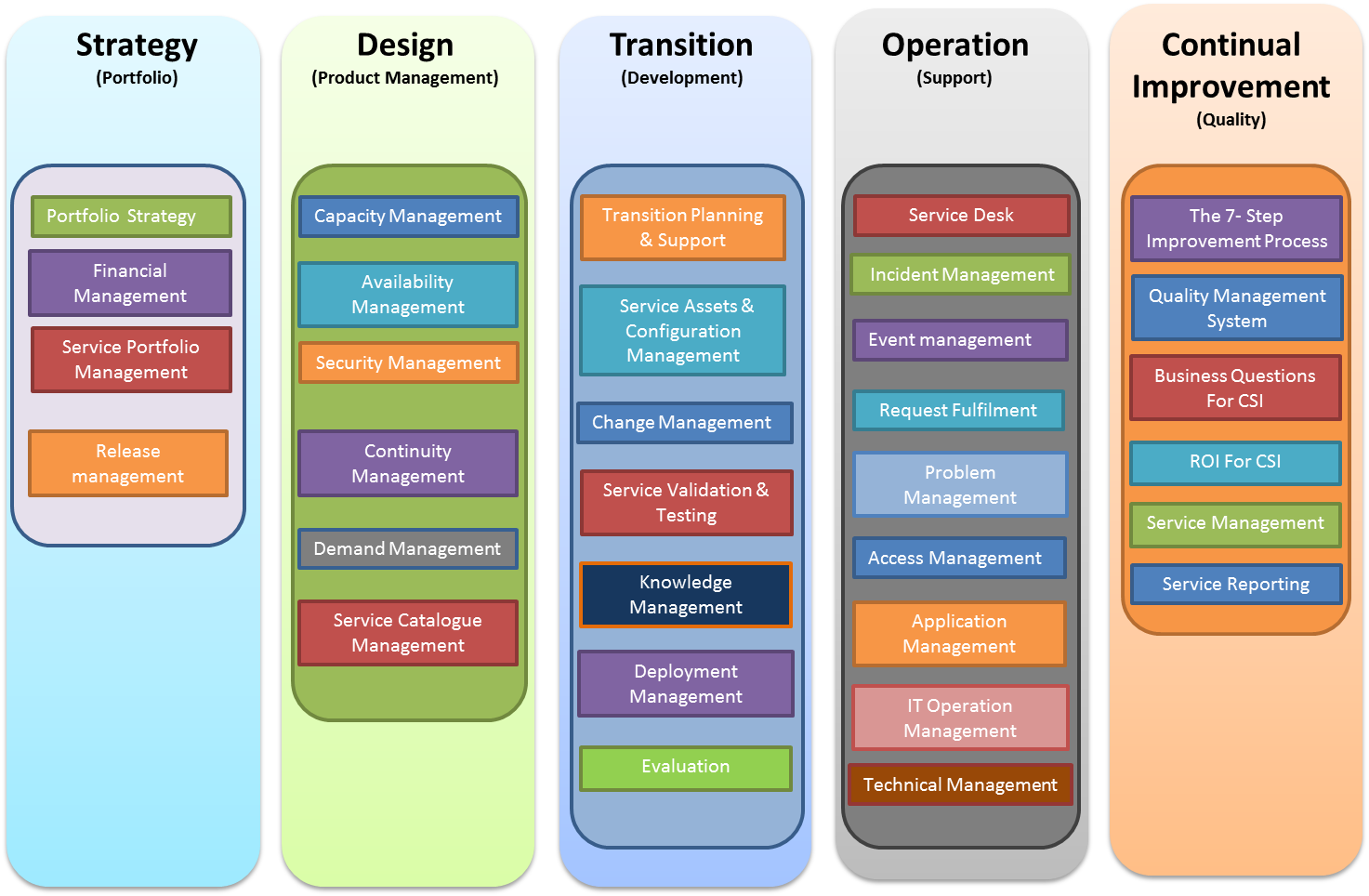 {: .img-fluid}
{: .img-fluid}
Created by the British government in 1980 to manage IT projects, this popular methodology defines services and their life cycle and divides project management into several areas:
- Service strategy – decide on best strategy
- Service design – design new services
- Service transition – build and deploy services
- Service operations – deliver services effectively
- Continual Service Improvement – learn from success and failure to improve efficiency and effectiveness
Adaptive Project Framework
Here motivated and self-organising teams in creative organisations adapt continually to changing requirements. Collaboration is at a high level and there is an element of agility. Features are:
- performance measurement
- quantitative risk assessment
- model analysis and testing
- avoidance of irreversible strategic decisions
- iterative decision making learning from past decision consequences
Rapid Application Development
In this methodology teams from various organisation functions such as finance, management, product development are placed together in a temporary team to concentrate on developing a product or service. The timescale itself is inflexible and if the project gets behind schedule, work is taken out so that at the planned end date of the project something has been delivered.
Rational Unified Process
The RUP project has 4 phases:
- Inception – business case and project scope are established
- Elaboration – deeper analysis of deliverables and the project or service to be delivered
- Construction – product or service is created
- Transition – product or service is delivered
RUP emerged from the IT company IBM and is usually used to manage software projects.
Event Change Methodology
This methodology assumes that events will disrupt the project and that an adverse event will trigger a series of further events which may additionally adversely affect the project. Methods are used to try and predict which external events will occur and what their effects will be.
Extreme Project Management
This methodology assumes that the initial project deliverable may not be the final one, which is to say that the project stakeholders may change their mind about what is being delivered. Authority to make changes is delegated to day to day project managers, allowing rapid reconfiguration of projects and deliverables. Work is broken up into small packets and dialogue with stakeholders and clients is constant and immediately fed back into the project management process, which is expected to be flexible.
Lean Methodology
Lean methodology tries to organise a delivery of the project objectives which achieves more with less resources. Project deliverables are analysed to make sure that delays and waste can be eliminated.
Six Sigma
This methodology measures and quantifies everything that goes wrong in a project and tries to aim for a very high effectiveness level of above 99%. Six Sigma uses the DMAIC approach:
- define – who speaks for customer, their goals, requirements
- measure – current process and capacity
- analyse – relationships between data to ascertain cause and effect in project area
- improve – design improved process and pilot it
- control – monitor new process to ensure any deviations dealt with before defects produced.
Six Sigma is not designed to be used on its own, and supplements project management methodologies as a tool to implement continuous improvement or total quality. It is most suited to manufacturing processes.
Lean Six Sigma
This methodology combines lean and Six Sigma to deliver very high effectiveness with minimum cost.
Process Based Project Management
This methodology tries to fit project management into an organisation’s existing processes. To an extent this is the reality of all project management methodologies as each organisation is different. Either the methodology can be adapted or the organisation is willing to adopt itself to incorporate the right methodology.
PRINCE2 – Projects in Controlled Environments
The methodology is favoured by the British government for its large and very expensive projects. A project board is created which carries out high level coordination of the project, and the board’s decisions are delegated to project managers for day to day implementation. A strength of this system is that key individuals, for whom the project is being delivered, can be appointed to the project board. PRINCE2 also breaks projects up into manageable stages and the idea is that each stage is managed as self continued, and on completion a new stage begins.
The success or otherwise of recent major British government projects proves that a project management methodology is only as good as the people operating it, and the plans made are only as competent as the people who draw them up.
PRINCE2 can effectively delegate the detail of projects to those who understand them while allowing the higher level managers to see an overview of progress through the project stages.
PRiSM – Projects Integrating Sustainable Methods
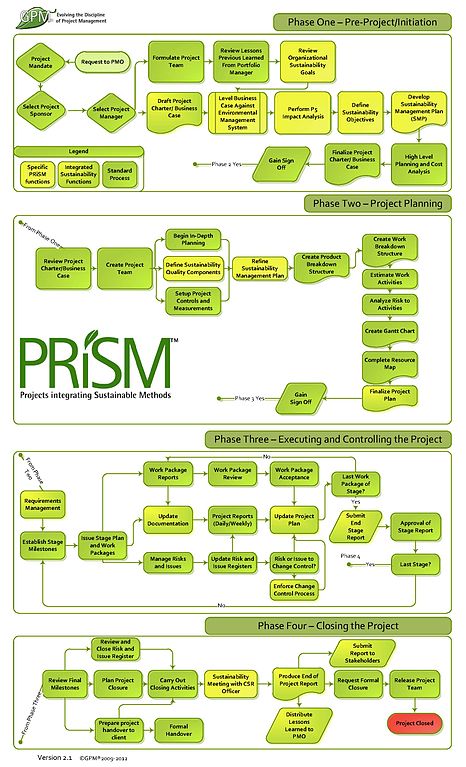 {: .img-fluid}
{: .img-fluid}
PRiSM is designed to complete projects with minimum environmental and social impact. Environmental and social sustainability is incorporated into project management thinking.
Benefits Realisation
This methodology does not stop when the project is delivered. Here analysis continues after delivery to see if the project delivered the benefits expected at inception, and if not why not. This methodology has tremendous potential to ensure that projects are not just started by and for the most powerful individuals or departments in an organisation, and to make sure that the projects delivered maximise advantage and resources used.
Choosing the right project management methodology is a project in itself and if you are embarking on major critical projects it is wise to get advice from experienced practitioners.